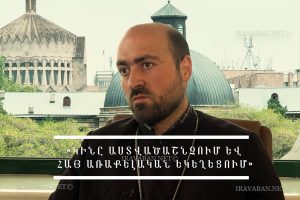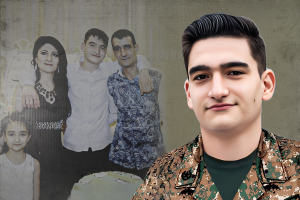THE EXTENT TO WHICH AN INDIVIDUAL’S HUMAN RIGHTS ARE PROTECTED DETERMINES THE LEVEL OF JUSTICE WITHIN THE COUNTRY
Born on January 20, 1956.
Between 1972 and 1979, she received her legal education at Yerevan State University.
Between 1979 and 1985 she served as a lawyer, and was also a member of the Lawyer’s Association.
Between 1985 and 1996 she served as a Supreme Court judge.
Between 1996 and 2003 she served as a judge for the Armenian Republic’s Constitutional Court.
Between 1997 and 1999 she was a member of the State Committee of Judicial and Legal Reforms.
Between 1998 and 2001 she served as a member of the State Constitutional Reforms Committee.
Between 1998 and 2003 she was the president of the Council of Judges.
From 2003 to the present, she serves as judge for the European Court of Human Rights.
– Mrs. Gyulumyan, what are the rooted human rights issues facing the European Court presently, and in this sense, are there needs for reform?
– It is obvious that at the creation of the European Court, the Court’s competence extended only to the protection of human rights and fundamental rights upon the ten founding members of the European Council. Presently the Council agreement presents 46 states, and each one of the more than 800 million residents of those countries may directly apply to this international judicial body for the protection of their violated rights. Now, with this expansion, the Court has already found around nearly 90,000 unconsidered applications. The amount of applications however is not practical. Therefore, the challenge arising in front of the Court today is to secure the work that has piled up, and to deal with the consideration of newly received applications within given time limits. With this said, the Court definitely has a need for reforms. At first instant, the Court is obviously doing everything possible within its boundaries to better its everyday tasks, and to make its work more productive. But that is not enough, because the Court is constrained by the European Council’s provisions, and it is necessary to reform the Council, of which steps have already been taken. Also, the Court’s work can considerably be lessened if the European Council’s 14 Protocol on the protection of human rights and fundamental rights goes into effect. It is necessary for the protocol to go into effect, for all the countries to ratify the Convention, and today already, only Russia has not ratified.
– According to you, which decisions carried out by the European Court in 2007 pertaining to human rights will have a lasting effect, and on this note, which countries are considered to be leading in having applied to the European Court for human rights related matters?
– It is possible to say that each decision by the European Court has at least an important effect upon the country that the decision was in regards to. Of course there are repeated cases of which, the decisions issued have become standard and are only important to the party applying to the Court. But there are decisions that provide interpretations and explanations, and strengthen the European Council by establishing cross-European standards. The last group of decisions which have a precedentary value are not only important to the country in which the decision was based upon, but rather, to all the other European countries as well. By adhering to precedents, it is possible to avoid similar mistakes, and to improve its own statutes and legislation by taking into account the European Court’s legal position.
Thus, it is important to translate and publish into Armenian those decisions by the European Court, which have a precedentary value. Furthermore, it is necessary and vital to translate and publish those decisions, which pertain directly to Armenia.
In regards to human rights related matters submitted to the European Court, it is difficult to consider any particular country as being the “leader,” because it is necessary to consider factors such as, the number of residents within the country, the informativeness of said residents about the European Court, and the existence of systematic violations, etc. However, I am able to point out those countries in which the European Court has received greater numbers of applications. These countries are Russia, Turkey, Romania, Ukraine, Poland, Czech Republic, Germany, France, Italy, Bulgaria, and Slovenia.
– What image can presently be drawn of the cases submitted from Armenia in regards to its protection of human rights, and are there actual effective mechanisms in Armenia to carry out justice and protect such human rights?
– In my opinion, justice is the basic protection of an individual’s human rights, and the extent to which an individual’s human rights are protected determines the level of justice within the country. If you are trying a man for his committed act but at the same time you are violating or depriving him of his rights, in reality you are depriving him of justice, and instead subjecting him to punishment. The state must not only not violate an individuals rights and liberties, but it is also required to create mechanisms to ensure that such protections become a reality. With only a number of applications being approved by the European Court, it is not enough to evaluate the existence or level of justice within the country. However, only in an effort to show the statistics, I can say that in comparison to the year 2005, the number of applications submitted to the Court in 2006 have increased in number by 13%. However, at the same time, the number of applications submitted by Armenia has decreased in number. By January 1, 2007, the European Court received 263 applications from Armenia. Nearly 70% of the cases submitted by Armenia are not approved by the Court, while the remainder of the applications are likely to be in the process for consideration. However, the Court has issued decisions concerning two cases. In those decisions, the Court first determined that there was a violation of an individuals right to participate in rallies and protests. Second, that there was a violation of the right to a fair trial.
– How do you evaluate the protection of human rights in present-day Armenia, and what are considered to be pressing matters which require urgent attention and resolve?
– As aforementioned, under two circumstances, the violation of rights contributed to a legislative gap. In the first instance, in the absence of legislation regarding rallies and protests, the Court found that with the prior Soviet Union’s legislative act, and with Armenia’s independence and new constitutional terms, it was impossible for the citizens to know what they were subjected to and how to conform, since these changes were unforeseeable. In this sense, I believe that no further issues will arise, because a conforming law has been approved. In the second instance, it is anticipated that all illegally brought evidence cannot be used. But, in my opinion, it is not anticipated that it will be left out of the criminal process, of which contributes to a violation. These examples bear witness that it is necessary to constantly improve legislation, and of course to instruct the implementers.
– What is your opinion in regards to the Armenian Republic’s present-day judicial-legal reforms, and to what extent is it moving alongside and in conformity with Europe’s legal system?
– I believe that the purpose behind the judicial-legal reforms is to make them conform to the European system, and I am hopeful that such a purpose will be achieved.















